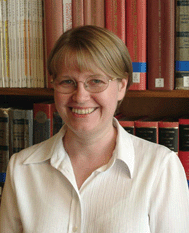Editorial
Welcome to the New Year and issue 1, 2006 of The Analyst. The New Year is always a good time to reflect on and learn from the past year and look to the future.Chair of The Analyst Editorial Board
Firstly, it is important that we express our thanks to the outgoing Chair of The Analyst Editorial Board, Dr Gillian Greenway (University of Hull, UK) for her very significant contribution to the journal over the last four years. Under Gillian's guidance, the journal has gone from strength-to-strength and she has led the Editorial Board's efforts to increase the quality and scientific impact of the journal. In 2002, together with the Scientific Editor, Mike Thompson, Gillian was instrumental in setting out future policy for publication in The Analyst. In her role as Chair of the Board, Gillian never wavered from applying the principles specified in the editorial that followed1 and the fruits of this effort are clearly evident in the impact that the journal is exhibiting. | ||
| Plate1 Gillian Greenway | ||
We are delighted to announce that Professor Elizabeth (Lisa) Hall (University of Cambridge, UK) succeeds Gillian as Chair of The Analyst Editorial Board. Lisa has been a world leader in bioanalytical chemistry for a number of years and is particularly widely recognised for her work in biosensor technology and enzyme electrochemistry. This research excellence was recently recognised by both the University of Cambridge in her promotion to the rank of Professor and in the awarding of the SAC Gold Medal in analytical chemistry by the RSC. The Board is extremely confident that Lisa will continue to lead the journal to greater heights in terms of article quality and impact. Lisa was recently profiled in the i-section of The Analyst.2
 | ||
| Plate2 Lisa Hall | ||
Highest ever impact factor: 2.783!
The Analyst's most significant achievement occurred in June 2005 when the 2004 ISI® impact factors were released. We were delighted to see the impact factor jump to its highest ever at 2.783 – an impressive increase of 23% over the previous year. Calculated annually, ISI® impact factors provide an indication of the quality of a journal – they take into account the number of citations in a given year for all the citeable documents published within a journal in the preceding two years.This demonstrates the increase in the quality of work published in The Analyst and our sincere thanks must go to our authors and referees for upholding the high standards of the journal.
It is worth noting that alongside the ACS Publication, Analytical Chemistry, The Analyst is the second highest impact general analytical chemistry journal. This demonstrates the recognition and status that researchers place in society published work.
Coming soon: Emerging Investigators
This year will see the publication of the third Emerging Investigators special issue, co-ordinated by Dana Spence and Justin Gooding, which will showcase some of the work of our future stars of analytical science.Technological developments
On a more general note, 2005 has seen RSC Publishing invest significantly in technological developments across all of its products. First there was the introduction of the new website in the summer which included a contemporary, fresh look and an enhanced structure for improved and intuitive navigation between relevant, associated content. The improvements to the technological infrastructure have made the site more flexible and efficient, and better equip the RSC to deliver enhanced publishing products and services for its customers in the future. The new look was just the start and towards the end of the year we were pleased to provide further enhancements in the form of RSS feeds and ‘forward linking’ facilities.RSS feeds
RSS, or ‘really simple syndication’, is the latest way to keep up with the research published by the RSC. The new service provides subscribers with alerts as soon as an Advance Article is published in their journal of choice. Journal readers simply need to go to the journal homepage, click on the RSS link, and follow the step-by-step instructions to register for these enhanced alerts. RSS feeds include both the graphical abstract and text from a journal's contents page – i.e. they deliver access to new research straight to a readers PC, as soon as it is published! Many feed reader software packages also have the added benefit of remembering what has been read previously, which in turn makes tracking and managing journal browsing more efficient.Forward linking
‘Forward linking’, the reverse of reference linking, enables readers to link from any RSC published paper to the articles in which it is cited. In essence, it allows researchers to easily track the progression of a concept or discovery, since its original publication. With one click of a button (on the ‘search for citing articles’ link) a list of citing articles included in Cross-Ref is presented, complete with DOI links.At a time when research is becoming increasingly interdisciplinary in nature and the amount of published works continues to grow, it is hoped that the new technology, developed in conjunction with Cross-Ref, will significantly reduce the time spent by researchers searching for information.
These developments demonstrate the investment in publishing products and services over the past year and 2006 will see us enhancing our products further, with improvements to the HTML functionality of all journals and ReSourCe (the author and referee web interface) already underway.
Free access to Molecular BioSystems…
Following its successful launch in 2005, the RSC's new monthly chemical biology journal Molecular BioSystems goes from strength-to-strength. Devoted to publishing the best work in chemical biology with a particular focus on the interface between chemistry and the -omic sciences and systems biology, many top authors from prestigious organisations around the world have already submitted articles. The journal has been very well-received in the community – and subscribers to The Analyst in 2006 will continue to receive free online access to this exciting new addition to the RSC portfolio.…and the Chemical Biology Virtual Journal
Chemical biology content published in The Analyst is highlighted in the Chemical Biology Virtual Journal. The portal, which was launched in 2002 in recognition of the significant amount of chemical biology material published across RSC journals, enables interested readers to readily access relevant items. All chemical biology articles and related papers published in RSC journals are drawn together online every two weeks, with a selection of the primary literature free to access for a month.Not just journals…
As well as an impressive portfolio of prestigious journals, the RSC has a significant collection of book titles. The first titles in three new series: RSC Biomolecular Sciences; RSC Nanoscience & Nanotechnology Series; and Issues in Toxicology were published in 2005, with further titles due during 2006. Future growth in the books publishing programme is planned, which reflects the increasingly interdisciplinary nature of the chemical sciences.We are confident that The Analyst will continue to bring you high quality new science and a selection of topical and general interest i-section articles throughout the coming year. We look forward to your continued support.
With best wishes for 2006
Claire Darby
Editor
Michael Thompson
Scientific Editor
References
- M. Thompson and G. Greenway, Analyst, 2002, 127(5), iii RSC.
- E. A. H. Hall, Analyst, 2004, 129(8), 684 RSC.
| This journal is © The Royal Society of Chemistry 2006 |
